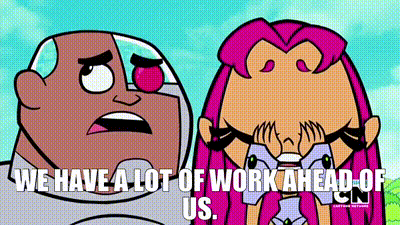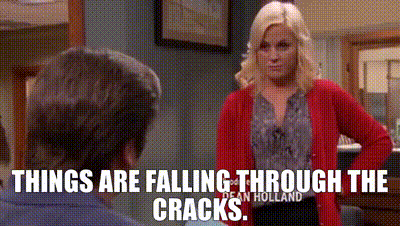#Task Tracking
Explore tagged Tumblr posts
Text
Working on differentiating between named items with the Bring cue.
I joke a lot about him being Dinky and having three brain cells. But truly he's such a good and smart boy and I appreciate him so much.
#dogblr#forte#belgian tervuren#psychiatric service dog#service dog#task tracking#task trained service dog#he's a good egg
41 notes
·
View notes
Note
How much paperwork does a game designer or other “trench level” game developers deal with? Does the amount of paperwork increase the higher up the chain you go?
We all tend to do a lot of "paperwork" but it's all digital - a lot of web-based forms. In order to keep track of all of the tasks that need doing, we use task-tracking software like Jira, Trello, Hansoft, and the like in order to keep the project management up to date. Producers and leads create these tasks, assign them priorities, and then dole them out to the appropriate developers to complete.

Larger tasks like "Build the Ice Dungeon level" are assigned to the Ice Dungeon level owner. Obviously, the Ice Dungeon is too big for a single task, so we break it down into smaller sub-tasks like "Build the boss fight for the Ice Dungeon", "Build the layout for the Ice Dungeon", "Build the regular encounters for the Ice Dungeon", and so on. These sub-tasks are assigned to the relevant stakeholders and those sub-tasks can be broken down further into smaller and smaller subtasks. Each task is its own bundle of work that needs doing, with its own priority and state of progress. We do the work, we complete the task, we mark it as done, and move on to the next. QA validates the tasks as complete, then production closes them out and everyone moves on to their next respective task.

Team leads and producers collectively spend a lot of their time creating, assigning, tracking, and closing out these tasks. They spend a lot of their time in meetings figuring out what the tasks that are still needed, which tasks are more important, what the task requirements are, who will get assigned those tasks, what potential task blockers and dependencies might be, and tracking the speed at which the tasks are being completed (in order to figure out whether we're on target to hit our deadlines).

Besides the leads, some specific disciplines tend to do more paperwork - QA spends a huge amount of time filling out bug reports, designers have to write design documents, and production have to create most/all of the non-bug tasks to be tracked.
[Join us on Discord] and/or [Support us on Patreon]
Got a burning question you want answered?
Short questions: Ask a Game Dev on Twitter
Long questions: Ask a Game Dev on Tumblr
Frequent Questions: The FAQ
14 notes
·
View notes
Text

Ever Feel Like Your To-Do List is Managing You?
Wispa Pro Tips for Stress-Free Task Management:
✅ Set Daily Priorities—Focus on tasks that truly matter each day ✅ Assign with Purpose—Clear task ownership leads to faster, smoother delivery ✅ Track Progress Frequently—Wispa’s timeline view keeps everything in sight ✅ Automate Routine Work—Set reminders, automate follow-ups, and schedule invoices effortlessly
Bonus Tip: Use Wispa’s recurring task feature to stay consistent and never miss a beat!
0 notes
Text
CRMLeaf Features Built to Improve Sales and Customer Relationships

In this blog, we’ll explore the key features of CRMLeaf that are designed to elevate your sales process and enhance customer relationships at every stage.
Read the full blog
#CRMLeaf#Sales CRM#Business CRM#CRM software#Lead management#Customer engagement#Project management#HR software#Payroll system#Billing CRM#Task tracking#Team collaboration#Pipeline management#Ticketing system#Employee tracking#Recruitment tool#Data security#Reports & insights#Role-based access
0 notes
Text
Simplify your workflows and enhance productivity with VastEdge’s top-notch project management software tailored for your business needs.
#project management software#workflow management#business productivity tools#task tracking#team collaboration
0 notes
Text
Top Task Management Tools for Streamlining Your Workflow
In today’s fast-paced work environment, using the right task management tools is essential for streamlining your workflow and enhancing productivity. Popular tools like Trello, Asana allow you to organize tasks, set priorities, and track progress visually intuitively. With features like collaboration, file sharing, and time tracking, these platforms help teams stay aligned and individuals focus on their goals. Tools like Todoist and Microsoft To-Do are great for personal task management, while ClickUp and Notion offer flexible solutions for project management and cross-team collaboration. Integrating these tools into your daily routine allows you to effectively manage workloads, improve communication, and stay on top of deadlines, making your workflow more efficient and organized.
More info: https://ahalts.com/products/hr-management

#task management tools#workflow management#productivity tools#project management software#task tracking#team collaboration tools#time tracking software#personal task management
0 notes
Text
Looking for a way to enhance your council and committee management? Majles Tech has you covered with its advanced solution designed for seamless administration and effective governance.
Features include:
Centralized management for all council and committee activities.
Streamlined meeting scheduling and management.
Secure document storage and easy access.
Real-time collaboration tools for efficient teamwork.
Advanced security to protect sensitive information.
Transform how your organization manages its councils and committees by exploring Majles Tech’s comprehensive solution. Check it out now: Majles Tech Council and Committee Management.
#Majles Tech#council management#committee management#board meeting management#task tracking#electronic voting#video conferencing#governance software#document archiving
0 notes
Text
Online Tools & Software That Can Help You Track Assignment Deadlines
In the following article, we will mention some online tools and Windows software that can help you track deadlines for your educational assignments. Date Calculator (Online Tool) Although a date calculator can not directly give you assignment deadlines, it can help you manage deadlines in less time. There are many such tools available online. Here, we will discuss a brief review of the…

View On WordPress
#assignment deadlines#management#online assignment tools#organization#planner#productivity#software#task tracking#Time Management#track
0 notes
Text
Task Management Techniques for Project Managers: Streamlining Workflow and Meeting Deadlines
Task management lies at the core of successful project management. For project managers, efficiently handling tasks, deadlines, and resources can mean the difference between project success and failure. In this article, we'll explore various task management techniques that project managers can employ to streamline workflow, enhance productivity, and meet project deadlines effectively.
Understanding Task Management
Task management encompasses the processes, tools, and techniques used to plan, organize, assign, and track tasks within a project. It involves prioritizing tasks, allocating resources, and ensuring that deadlines are met. Effective task management is essential for keeping projects on track and achieving desired outcomes.
Challenges Faced by Project Managers
Project managers often encounter various challenges in task management, including unclear priorities, resource constraints, and communication breakdowns. Poor task management can lead to missed deadlines, budget overruns, and compromised project quality. It's crucial for project managers to address these challenges proactively to ensure project success.
Key Components of Effective Task Management
Effective task management involves several key components, including prioritization techniques, time management strategies, and communication tools. By mastering these components, project managers can streamline workflow and optimize project outcomes.
Streamlining Workflow
Streamlining workflow begins with setting clear goals and objectives for the project. Project managers should break down tasks into smaller, manageable components and assign them to the appropriate team members based on skills and availability. By dividing work effectively, project managers can ensure that tasks are completed on time and within budget.
Utilizing Technology for Task Management
Technology plays a vital role in modern task management. Project managers can leverage task management software to create, assign, and track tasks efficiently. When choosing task management tools, project managers should look for features such as task prioritization, deadline reminders, and collaboration capabilities to enhance team productivity.
Effective Time Management Strategies
Time management is critical for project success. Project managers can employ various time management strategies, such as time blocking and the Pomodoro Technique, to improve focus and productivity. Setting realistic deadlines and regularly reviewing progress are also essential for managing time effectively.
Communication and Collaboration
Communication forms the foundation of effective task management. Project managers should establish clear channels of communication and utilize project management platforms to facilitate collaboration among team members.Consistent check-ins and updates ensure everyone stays on the same page.
Tracking and Monitoring Progress
Tracking progress is essential for identifying potential bottlenecks and addressing issues promptly. Project managers can use progress tracking tools to monitor task status, identify dependencies, and allocate resources effectively. Regular check-ins with team members provide opportunities to discuss progress and address any concerns.
Delegating Tasks
Delegating tasks allows project managers to leverage the skills and expertise of team members effectively. By identifying tasks suitable for delegation and empowering team members to take ownership, project managers can distribute workload evenly and maximize efficiency.
Handling Project Delays
Despite careful planning, project delays can occur due to unforeseen circumstances or unexpected challenges. Project managers should be proactive in identifying the causes of delays and implementing corrective actions to minimize their impact on project timelines.
Managing Stakeholder Expectations
Managing stakeholder expectations is crucial for project success. Project managers should communicate project progress and potential delays transparently, setting realistic expectations and ensuring stakeholders are informed throughout the project lifecycle.
Measuring Success
Measuring success involves tracking key performance indicators (KPIs) related to task management, such as project completion rate and adherence to deadlines. Celebrating achievements and lessons learned helps reinforce positive outcomes and drive continuous improvement.
Continuous Improvement
Continuous improvement is essential for evolving task management processes and optimizing project performance. Project managers should seek feedback from team members, stakeholders, and project sponsors to identify areas for improvement and implement iterative changes.
Conclusion
Effective task management is essential for project managers tasked with streamlining workflow and meeting project deadlines. By employing prioritization techniques, time management strategies, and communication tools, project managers can optimize task management processes and drive project success. Continuous improvement and proactive problem-solving are key to overcoming challenges and delivering successful projects.
FAQs
What are some common challenges in task management for project managers? Ans: Common challenges include unclear priorities, resource constraints, and communication breakdowns.
How can project managers streamline workflow effectively? Ans: Project managers can streamline workflow by setting clear goals, breaking down tasks, and assigning them to the right team members.
What role does technology play in task management? Ans: Technology, such as task management software, helps project managers create, assign, and track tasks efficiently.
Which time management techniques work well for project managers? Ans: Time blocking, the Pomodoro Technique, and setting realistic deadlines are effective time management strategies.
How important is communication in task management? Ans: Effective communication is crucial for keeping team members aligned and informed, facilitating collaboration, and addressing challenges proactively.
#Task Management#Project Management#Time Management#Productivity#Task Tracking#Task Prioritization#Workflow Optimization#Team Collaboration#Deadline Management#Task Delegation#Task Organization#Task Efficiency#Task Automation#Task Software#Task Planning
0 notes
Text
From Backlogs to Sprints: Mastering Scrum Tools for Success
Scrum, a powerful framework in the dynamic world of project management, has emerged to foster collaboration, adaptability, and efficiency. At the heart of Scrum lies a set of tools designed to streamline processes, enhance communication, and drive results. In this comprehensive guide, we'll dive into the complexities of mastering Scrum tools for unparalleled success.
Understanding Scrum:
Before we dive into the tools, let's establish a foundational understanding of Scrum. At its core, Scrum is an agile methodology that emphasizes iterative development, self-organization, and continuous improvement. Scrum teams work in short, time-boxed iterations called sprints, during which they aim to deliver a potentially shippable product increment.
Backlogs:
The product backlog serves as the single source of truth for all work that needs to be done on a project. It is a dynamic list of user stories, features, enhancements, and bug fixes prioritized by the product owner based on value and urgency.
Sprints:
Sprints are the heartbeat of Scrum, typically lasting between one to four weeks. During a sprint, the development team focuses on completing a set of backlog items committed during sprint planning.Burndown charts and Kanban boards offer valuable insights into team velocity and workflow efficiency.
Daily Stand-ups:
Daily stand-ups, or daily scrums, are short, time-boxed meetings where team members synchronize their activities and discuss any impediments. While stand-ups can be conducted in person, they are often held virtually using various tools. These platforms enable teams to connect regardless of location, fostering collaboration and transparency.
Sprint Reviews and Retrospectives:
After each sprint, the team organizes a sprint review to showcase the finished work to stakeholders and collect valuable feedback. Sprint retrospectives follow, providing an opportunity for the team to reflect on what went well, what could be improved, and how to adapt moving forward. Continuous Integration and Deployment:
Metrics and Reporting:
Effective measurement and reporting are critical for assessing team performance, identifying bottlenecks, and making data-driven decisions. Scrum tools provide customizable dashboards and reports, enabling teams to track key metrics such as velocity, cycle time, and sprint burndown.
Conclusion:
From managing backlogs to orchestrating sprints, mastering Scrum tools is essential for driving success in agile project management. By leveraging the right tools and practices, teams can collaborate more effectively, deliver value iteratively, and adapt to changing requirements with confidence. Whether you're just starting your Scrum journey or looking to optimize your existing processes, investing in the right tools can make all the difference in achieving your project goals.
#projectmanagement#agile methodology#software development#team collaboration#product backlog#sprint backlog#task tracking#agile tools
0 notes
Text
Money Coach: An Ultimate Guide to Personal Finance Management
Discover the ultimate productivity companion with our innovative digital task management app. Seamlessly organize your to-dos, set priorities, and collaborate effortlessly with team members. With intuitive features and customizable settings, stay focused and achieve your goals with ease. Try our app today and revolutionize the way you work!
#Life transformation#Money Coaching#Life Coaching#Abundance Coaching#Relationship Coaching#Law Of Attraction Coaching#Mindset Coaching#Task management#productivity app#digital organizer#to-do list#project management#collaboration tool#prioritize tasks#team productivity#goal setting#time management#task tracking#productivity software#workflow optimization#efficient task management#team collaboration
0 notes
Note
How long is the scoping process for a game development typically in the industry, and does it vary greatly depending on what type of game, like from an open world PC game, to a mobile game, to a game based on a Hollywood IP?
Scoping is an ongoing process and not a particular phase of development that we finish. Even though we try to figure out what we can do early on, we still have to make scope adjustments as we follow the schedule. If higher priority tasks fall behind, it is only natural to cut lower priority tasks so we can redirect those resources to the higher priority tasks.

At most studios, we work in milestones. A milestone is a longer period of time where we have a set of targets to deliver. When the game is green lit, the general milestone schedule is agreed upon and high level goals are set. This process can take a few months while we figure out what the game is about. The establishment of the milestones is very important, because it provides a means of tracking the game's overall development progress. Independent studios that have contracts with a publisher usually get paid for each successful milestone - the funding is given when the project reaches the goals set for the milestone.

Early in the milestone, we usually have some planning meetings where the high-level goals are broken down into smaller tasks that get estimates from the developers in the trenches. If the tasks are too difficult to estimate by themselves, we break them down further until we get some consensus as to how expensive a task will be. Then, the producers take all those estimates, prioritize them, add them up, and compare to how much time we have in the schedule for the milestone. Starting from the highest priority and working their way down, they put as many of the tasks that we can do and will fit into the schedule in, and the other tasks that are either lower priority or have dependencies on the current tasks get put into the backlog. Then, as we progress through the milestone, they'll update the schedule as additional tasks get cut or added based on our progress and speed.

Sometimes tasks slip the schedule for unforeseen reasons - our estimates are off, the person who was working on the task left the company, the licensor vetoed the idea, there's a new thing that takes priority, etc. When this happens, we can sometimes push the task into the next milestone (we call this punting), as long as the overall milestone goals are still hit. If we can't hit the overall milestone goals, the milestone is delayed and the studio may not get paid until the milestone goals are reached. If we consistently miss milestones by too much and the project is in danger of getting cancelled.
[Join us on Discord] and/or [Support us on Patreon]
Got a burning question you want answered?
Short questions: Ask a Game Dev on Twitter
Long questions: Ask a Game Dev on Tumblr
Frequent Questions: The FAQ
#game production#milestone planning#working with a team#production schedule#prioritization#task tracking#working in the game industry
20 notes
·
View notes
Text

Is Your Workflow Secretly Holding Your Business Back?
Did you know most small teams lose 10+ hours/week switching between tools?
Wispa solves this by combining:
✅ Project Management ✅ Client Communication ✅ Task Tracking ✅ Team Co-Ordination
0 notes
Text

Day 8/100 days of productivity | Mon 26 Feb, 2024
It was a very productive Monday!
Got a lot of tasks done at work.
Started tracking the time spent on each distinct task at work, it really helped me get a lot done.
I started a new project with a new team today, and got firehosed with a stream of new information. I’ve got a lot of reading ahead of me, before I can meaningfully contribute to this project!
I heard back from one of the grad schools I applied to :)
I worked on a side project (building a dashboard to track my grad school applications)
Went shopping for groceries
My mum made homemade guava juice!!
0 notes
Text
oke it's 5pm and i've been day drinking but come closer. listen to me
i get asked for character writing advice quite a lot and i really don't feel qualified to give any but i have 1 (one) hack for relationship dynamics that hasn't failed me yet and it's the Ikea Test
if you're figuring out how to characterise a relationship (platonic or romantic) and you're struggling: just imagine them having to put together an ikea flatpack and write how it would go
#ramble#you would be Surprised#it's like how you don't fully know an actual person until you have to do some kind of Task with them#i saw another one of these that was 'lost in the woods' theory but this one is more low stakes akdfhdj#who's reading the instructions. who's keeping track of all the pieces. who tossed that one 'useless' extra screw#when it's done is it just 'we built the table today' or is it referred to as the Nordviken Incident forever#who is crying before it's even finished#etc etc#this has worked for every ship i've ever drawn source trust me bro
489 notes
·
View notes
Text



hiii half-assed volleyball au doods
#can u tell i got tired halfway thru drawing these#anyways LASWELL IN A TRACK SUIT LIKE WHATTTT#also idk why but no matter what color i put Alex in.. he looks more like a basketball player AHSHASH??? I DID MY BEST??#my art#2023#call of duty#call of duty: modern warfare#call of duty: modern warfare ii#call of duty: modern warfare iii#cod#codmw#codmwii#codmwiii#mw2#mw3#tf141#task force 141#art#fanart#digital art#digital drawing#sketch#doodle#cod volleyball au#activision#video games#ghost cod#soap cod#price cod#gaz cod
2K notes
·
View notes